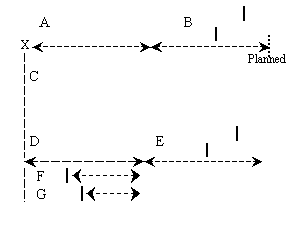Phantoms of generic items
In regular order-based planning, phantoms are treated in the following way:
- The phantom is replaced by the components in its BOM
- The phantom's routing is treated as part of the existing routing
If a generic item G has a phantom, the phantom's components and operations are offset relative to the planned order finish date of G. The way in which this is done depends on whether the phantom itself is a generic item or a normal item. Below you will find an example of both situations.
Example: generic phantoms of generic items
Consider the following situation:
- A generic item G1 has a generic phantom G2
- G2's generic BOM contains a (normal) component N3
- G2's generic routing contains one operation OP
In this situation, the planning proceeds according to the following diagram:
| A | Offset of N3 in G-BOM of G2 |
| B | Offset of G2 in G-BOM of G1 |
| C | N3 finish date of G1 order |
| D | Offset of OP in G-ROU of G2 |
| E | Offset of G2 in G-BOM of G1 |
| F | OP1 |
| G | OP2 |
Example: normal phantoms of generic items
Consider the following situation:
- A generic item G1 has a normal phantom N2
- N2's BOM contains a (normal) component N3
- N2's routing contains operations OP1 and OP2
In this situation, the planning proceeds according to the following diagram:
- (1) Offset of N3 in BOM of N2,
- Or:

| A | Order lead-time of N2 |
| B | Offset of N2 in G-BOM of G1 |
| C | N3 finish date of G1 order |
| D | Order lead-time of N2 |
| E | Offset of N2 in G-BOM of G1 |
| F | OP1 |
| G | OP2 |
Remarks:
- If an offset is specified in N2's BOM, this offset is used to offset N3; otherwise, N2's order lead-time is used.
- In a normal routing, no offset is available; instead, N2's order lead-time is used to offset N2's operations.
Note: You can specify an
item's order lead-time in the Item - Production (tiipd0101m000) session.